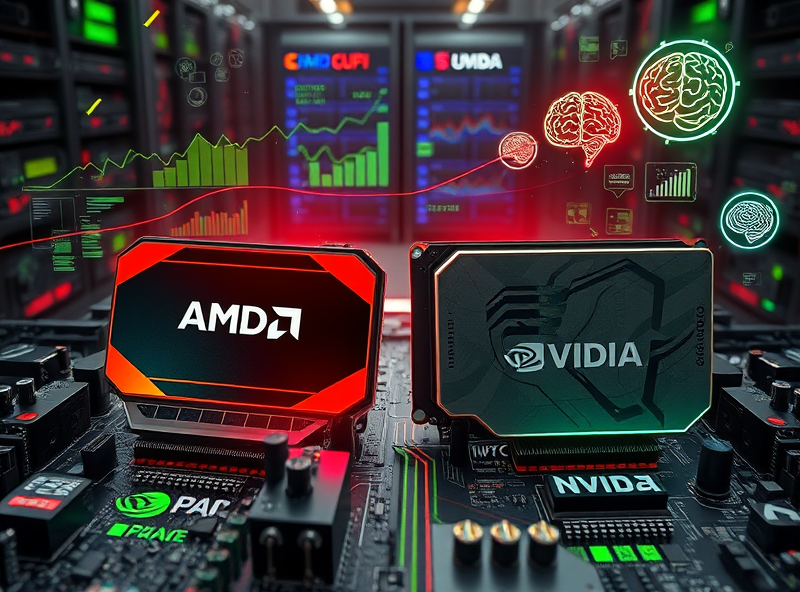Broadcom (AVGO) Stock: A Deep Dive into the Semiconductor and Software Giant

technology that powers our digital lives – the internet, smartphones, data
centers, and increasingly, artificial intelligence – companies like Broadcom
are working behind the scenes, providing the essential components and
software that make it all possible. Broadcom is a global leader in designing,
developing, and supplying a broad range of semiconductor and infrastructure
software solutions. But what does this complex technology company mean for
investors? Understanding Broadcom’s diverse portfolio, its strategic
acquisitions, and its key growth markets is essential for anyone interested
in AVGO stock.
Broadcom is a highly diversified technology company operating in
two main segments: Semiconductor Solutions and Infrastructure Software.
Unlike companies focused on a single type of chip or software, Broadcom
offers a wide array of products used across numerous end markets. Their
business model involves designing complex chips and software, manufacturing
them (often through third-party foundries), and selling them to large
customers like original equipment manufacturers (OEMs) and service providers.
Over the years, Broadcom has grown significantly through a series of major
acquisitions, integrating diverse technologies and businesses under one roof.
This strategy has shaped the company into the form we see
today.
The semiconductor and software industries are characterized by
rapid technological advancements, intense competition, and sensitivity to
global economic conditions and demand for electronic devices and digital
services. Factors like the build-out of 5G networks, the growth of cloud
computing and data centers, the increasing adoption of AI, and enterprise IT
spending all play a major role. Investing in a company like Broadcom means
engaging with these complex dynamics and understanding how the company plans
to leverage its broad portfolio, technological expertise, and strategic
acquisitions to drive future growth and profitability. Let’s explore the
different facets of Broadcom’s business and what they mean for
investors.
Understanding Broadcom’s Diverse
Portfolio
Broadcom’s business is broadly divided into two main segments:
Semiconductor Solutions and Infrastructure Software. The Semiconductor
Solutions segment is the larger of the two and includes a wide range of
products used in various end markets. This includes connectivity chips for
smartphones (like Wi-Fi and Bluetooth), networking chips for switches and
routers that power the internet and data centers, broadband chips for modems
and gateways in homes, storage adapters and controllers for enterprise
storage systems, and semiconductor solutions for industrial and automotive
applications. This segment’s performance is influenced by demand for
electronic devices, network infrastructure build-outs, and technological
transitions like 5G and Wi-Fi 6/7.
The Infrastructure Software segment provides a portfolio of
software solutions for mainframe and enterprise software, security software,
and business operations software. This segment was significantly built
through acquisitions like CA Technologies, Symantec’s enterprise security
business, and most notably, VMware. These software products help large
organizations manage their IT infrastructure, secure their data, and optimize
their business processes. Revenue in this segment is largely recurring, based
on software licenses, maintenance, and support agreements. The performance of
this segment is influenced by enterprise IT spending trends and the
successful integration and cross-selling of acquired software
portfolios.
This diversification across both hardware (semiconductors) and
software provides Broadcom with a broader base of revenue compared to
companies focused solely on one area. While the Semiconductor segment can be
more cyclical, the Infrastructure Software segment often provides more stable,
recurring revenue, which helps balance the overall business profile.
Understanding the specific products and end markets within each segment is
key to analyzing Broadcom’s performance drivers.
Driving Growth in Data Centers and AI
A significant portion of Broadcom’s growth is currently being
driven by demand from data centers and the increasing adoption of artificial
intelligence (AI). Broadcom provides a wide range of semiconductor solutions
essential for building and operating modern data centers, including
high-speed networking chips, custom silicon for cloud providers, and
connectivity solutions for servers and storage. As cloud computing continues
to expand and companies invest heavily in data center infrastructure to
support their digital operations, demand for these components
increases.
The rise of AI is creating significant new opportunities for
Broadcom. Training and running large AI models requires massive computing
power and high-speed data transfer within data centers. Broadcom’s advanced
networking chips and custom AI accelerators are crucial for enabling the
performance and efficiency of AI workloads. The company is working closely
with major cloud providers and AI companies to develop specialized silicon
solutions tailored to their specific needs. This exposure to the rapidly
growing AI market is a major potential growth driver for Broadcom’s Semiconductor
segment.
Furthermore, Broadcom’s software solutions, particularly those
from VMware, are essential for managing the complex virtualized
infrastructure within data centers and cloud environments. As organizations
deploy more workloads, including AI applications, the need for robust
infrastructure management software increases, benefiting Broadcom’s
Infrastructure Software segment. The convergence of hardware and software
solutions for data centers and AI is a key strategic area for
Broadcom.
Broadcom’s Strategic Software Segment
The Infrastructure Software segment, significantly expanded
through major acquisitions, represents a strategic shift for Broadcom. The
goal is to leverage the company’s expertise in serving large enterprise
customers and apply it to sticky, mission-critical software franchises. The
acquisition of VMware, one of the largest software deals in history,
dramatically increased the size and importance of this segment. VMware is a
leader in cloud infrastructure and business mobility software, providing
virtualization, cloud management, and networking solutions that are deeply
embedded in enterprise IT environments.
Broadcom’s strategy for its acquired software businesses,
including VMware, CA Technologies, and Symantec enterprise security, often
involves focusing on key enterprise customers, optimizing the product
portfolio, and driving recurring revenue through long-term contracts. The aim
is to generate stable, high-margin cash flow from these established software
franchises. While this strategy has sometimes involved changes to product
roadmaps or customer relationships, the overall goal is to create a
predictable and profitable software business that complements the more
cyclical semiconductor operations.
The success of integrating these large software businesses and
realizing the expected synergies and financial performance is crucial for
Broadcom’s overall investment thesis. The recurring nature of software
revenue provides a valuable counter-balance to the hardware side of the
business.
Financial Strength and Shareholder
Returns
Broadcom has demonstrated strong financial performance,
particularly in terms of revenue growth (often boosted by acquisitions),
profitability, and free cash flow generation. Key financial metrics for
investors include total revenue (broken down by segment), gross margin,
operating margin, net income, and earnings per share (EPS). The company
generally operates with healthy margins, reflecting the value of its
technology and its operational efficiency.
Free cash flow generation is a major strength for Broadcom. Free
cash flow is the cash left over after capital expenditures (investments in
R&D, manufacturing capacity, etc.) and is a critical indicator of the
company’s financial health and ability to return value to shareholders.
Broadcom has been a consistent and significant generator of free cash flow,
which is a key attraction for many investors.
Broadcom is committed to returning value to its shareholders,
primarily through dividends and share buybacks. The company has a history of
consistently increasing its dividend, making it an attractive stock for
income-focused investors. The dividend yield can fluctuate with the stock
price, but the consistent growth in the dividend payment itself reflects the
company’s strong cash flow generation and commitment to
shareholders.
Share buybacks are also a significant component of Broadcom’s
capital allocation strategy. By repurchasing its own shares on the open
market, the company reduces the number of outstanding shares, which can help
boost earnings per share and potentially increase the stock price over time.
Broadcom has been a consistent and significant buyer of its own stock,
reflecting its confidence in the long-term value of the company and its
commitment to returning excess cash to shareholders. Broadcom’s capital
allocation strategy prioritizes investing in the business for long-term
growth, followed by returning a significant portion of free cash flow to
shareholders through dividends and buybacks.
Navigating Competition and Industry
Cycles
Broadcom operates in highly competitive semiconductor and software
markets. In semiconductors, it competes with a wide range of companies,
including large, diversified players (like Qualcomm, Intel, AMD, Nvidia) and
numerous smaller, specialized companies, depending on the specific product
category and end market. Competition is based on factors like product
performance, technology leadership, pricing, quality, customer relationships,
and supply chain capabilities.
In infrastructure software, Broadcom competes with major
enterprise software providers (like Microsoft, IBM, Oracle, SAP) and
specialized software vendors, depending on the specific product area (e.g.,
cybersecurity, mainframe software, virtualization). Competition is based on
product features, reliability, customer support, pricing, and the ability to
integrate with existing IT environments.
The semiconductor industry is also cyclical, influenced by global
economic conditions and demand for electronic devices. While Broadcom’s
diversification across end markets and its stable software revenue help
mitigate some of this cyclicality, its Semiconductor segment remains
sensitive to industry downturns. Navigating these cycles effectively requires
managing production levels, inventory, and costs while continuing to invest
in R&D for future products.
Broadcom’s Role in Global Connectivity
Broadcom plays a fundamental role in enabling global connectivity.
Its chips are essential components in the infrastructure that powers the
internet, from the data centers that store and process information to the
routers and switches that direct traffic, and the broadband equipment that
brings connectivity into homes and businesses. Its wireless chips are also
critical for mobile devices, enabling Wi-Fi and Bluetooth
connectivity.
As the world becomes increasingly connected, with more devices,
higher data consumption, and the rollout of new technologies like 5G and
Wi-Fi 6/7, the demand for Broadcom’s connectivity solutions is expected to
continue growing. The company’s expertise in high-speed networking and
wireless technologies positions it well to benefit from these long-term
trends in global connectivity.
Conclusion: A Diversified Tech Powerhouse Built Through
Strategy
In conclusion, Broadcom Inc. (AVGO) is a major technology company
with a diversified portfolio spanning Semiconductor Solutions and
Infrastructure Software. The company has grown significantly and
strategically through a series of major acquisitions, integrating diverse
technologies to serve a wide range of end markets, with a growing focus on
data centers and AI. While operating in highly competitive and sometimes
cyclical industries, Broadcom benefits from its broad product portfolio,
technological expertise, strong customer relationships, and a growing base of
stable, recurring software revenue. The company is a strong generator of free
cash flow and is committed to returning value to shareholders through
dividends and share buybacks.
For investors seeking exposure to the technology sector with a
focus on essential semiconductor components and enterprise software,
understanding Broadcom’s diverse business segments, its strategic acquisition
history, its key growth drivers (data centers, AI, connectivity), and its
financial discipline is essential for evaluating its potential as a long-term
investment. Despite the complexities of its integrated model and the
challenges of operating in dynamic markets, Broadcom’s established position
and strategic focus make it a significant company to consider in the
technology sector.







